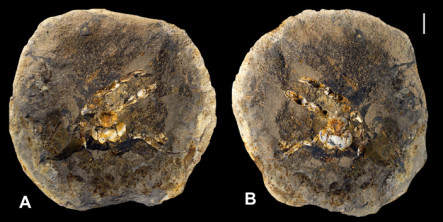A new article by an international team of paleontologists with the participation of a senior researcher at the Atlantic Branch of the Institute of Oceanology of the Russian Academy of Sciences, Eduard Mychko, reports on the discovery of a fossil hermit crab in mid-Cretaceous (110 million years) deposits of the Vladimir region. This ancient hermit crab, very similar to modern representatives of the genus Tylaspis (family Parapaguridae), was found in the shallow sediments of an ancient sea, and modern tilaspis live at kilometer depths of the ocean and do without the protective shell house. The name of the new taxon, Mutotylaspis tripudium, can be translated as “the dancing monster Muto” (in honor of the fictional character from the Godzilla universe). It's incredible that this group of unusual hermit crabs has changed so little in more than 100 million years. This is the second ancient hermit crab in the geological record of Russia.
Left and right halves of a concretion with fossilized remains of the paguroid Mutotylaspis tripudium.
The length of the scale segment is 10 mm.
Research Article:
René H. B. Fraaije, Eduard V. Mychko, Leonid S. Barsukov, John W. M. Jagt. A new mid-Cretaceous hermit crab (Crustacea, Anomura) from Central Russia sheds new light on paguroid evolution // Cretaceous Research. 2024.
DOI: 10.1016/j.cretres.2023.105749




